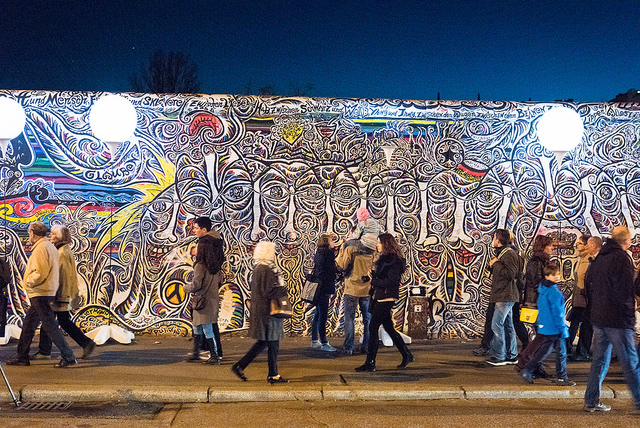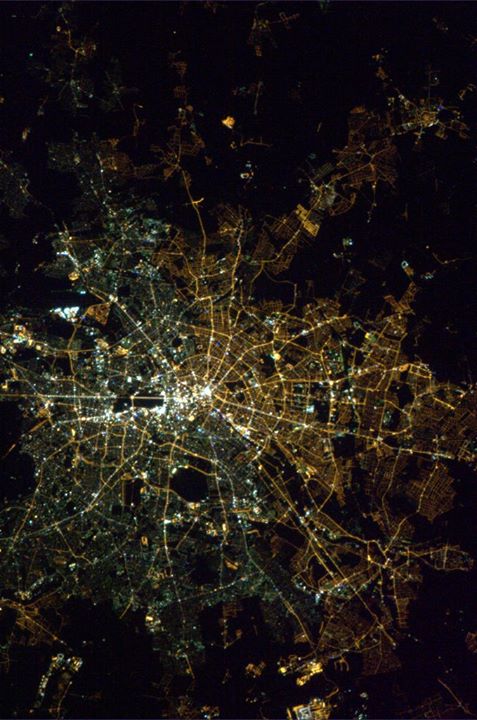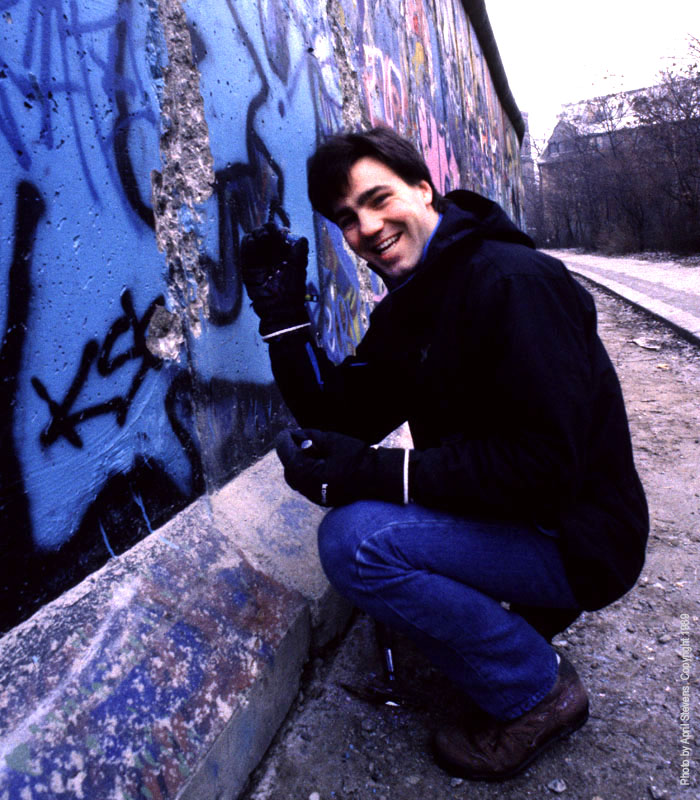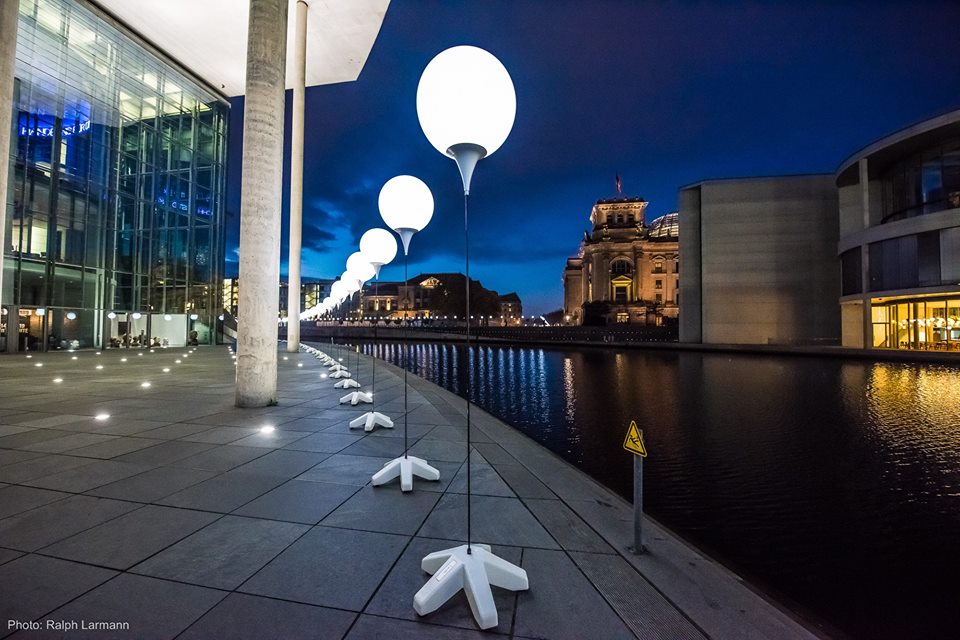

Germany, and much of the world, this weekend marked the 25th anniversary of the fall of the Berlin Wall. It remains the singular event to symbolize the end of the Cold War. It marked the end of the Iron Curtain between Eastern and Western Europe, and the rise of the new global economic and political orders that tore apart the former USSR and set the stage for the 21st Century world.
Ours is today a chaotic, fractious, polarized world. We have not experienced anything like the “end of history” predicted then so triumphantly by some in the West. For some global citizens life has never been better. For most, life is a struggle, and the notion of thriving a dream. Rising inequality stalks even the richest of Western nations. The world’s sixth mass extinction of species, driven by humanity, is well underway. Climate change, and the exhaustion of our essential natural resources, loom over humanity’s future.
But, as Jonathan Manthorpe points out in our pages this week (intro below), the “end” is nowhere nigh — the Fat Lady has not sung. And there is no better symbol than Berlin’s fallen wall, of the end of the grim and terrifying Cold War, of long years when children grew up in the shadow of nuclear apocalypse. That people could topple the Berlin Wall is proof of our power, and offers hope for the future.
The city of Berlin was packed this weekend with both revellers and sober pundits. The Berlin State Orchestra played Beethoven’s Ode to Joy; a line of white balloons along the route of the wall were released into the sky; British performer Peter Gabriel sang a version of David Bowie’s Heroes; thousands attended a “citizen’s party” at the Brandenburg Gate.
Chancellor Angela Merkel said the fall of the wall showed the world that dreams could come true. And former Soviet president Mikhail Gorbachev used the occasion to issue a grim warning: he said the world is “on the brink of a new cold war” — for which he blamed the West. (See recommended reading, below.)
Amid division there is hope, and vice versa.
To mark the occasion F&O offers a special lineup of Berlin Wall stories and images:
History still waits for the Fat Lady to sing, by Jonathan Manthorpe (paywall)
The world would be a different place if Francis Fukuyama had been right in the essay he wrote, shortly before the demolition of the Berlin Wall 25 years ago this weekend, arguing that the Soviet Union collapse was indeed “the end of history.” “What we may be witnessing,” wrote the Stanford University political scientist, “is not just the end of the Cold War, or the passing of a particular period of post-war history, but the end of history as such: that is, the end point of mankind’s ideological evolution and the universalization of Western liberal democracy as the final form of human government.” …read more

BERLIN, 1989: A Photo-essay, by Greg Locke
In the fall of 1989 a friend and I were watching, from a distance, the unravelling of the Soviet Bloc countries in Eastern Europe. Being experienced journalists we knew this was the place to be in the next few weeks. I plunked down the credit card, secured an assignment guarantee and we landed in Berlin just days before the fall of the Berlin Wall and the opening of the famed and iconic Brandenburg Gate. … read more
Children born just after the Berlin Wall fell were lower achievers. By Arnaud Chevalier and Olivier Marie
Germany and the rest of Europe are celebrating the 25th anniversary of the collapse of the Berlin Wall and the associated communist regimes in Eastern Europe. This event had colossal repercussions in the economic development of the region but also, and maybe less obviously, on its demography. Following the collapse of the Communist regimes, fertility in Eastern Europe went into a sharp decline. This was especially marked in East Germany which over a short period experienced a 50% drop in births (Figure 1) which was dubbed the “most substantial fall in birth rates that ever occurred in peacetime”. … read more
Critical Assembly: A Drama Critic Remembers Berlin. by Brian Brennan (Paywall)
We came to Berlin, a city politically divided, to talk about theatre criticism. We were 140 writers from 40 countries and for the better part of a week we wrangled like arms control negotiators. It was the autumn of 1987, the year marking the 750th anniversary of Berlin’s founding. During the previous centuries, the city had survived wars and destruction to become one of Europe’s great centres of arts and culture. Though split by realpolitik, it remained united artistically.
I went there in my capacity both as the drama reviewer for the Calgary Herald and as president of the Canadian Theatre Critics Association. My editors found it odd I would want to go to an international conference dealing with a topic – theatre criticism throughout the ages – that they saw as being distantly removed from Canada’s immediate cultural concerns. But I felt it would be interesting, perhaps inspirational, to talk with critics from places where theatre is taken more seriously than hockey or soccer …. read more
Graffiti Interpretations of the Berlin Wall. By Gavin Kennedy

The Berlin Wall was one of the greatest Cold War symbols. When it came down in 1989 it marked not only the reunification of Germany, but a wider collapse of communism in Eastern Europe. A quarter century later — years in which Germany grew to become an economic leader in the region, and a world leader in providing clean energy — the wall remains a potent symbol. Policy analysts, historians and urban planners have myriad interpretations of its symbolism, but the most vivid are surely by Germany’s graffiti artists. Here, they have the last word. … read more
Postcard from Poland as the Iron Curtain lifted* By Rod Mickleburgh
Being in Warsaw while East Germany teetered had its fascination. It was the dawn of the free market in Poland. An entrepreneur had set up the country’s first fledgling stock market on the second floor of the city’s ramshackle, old Fisherman’s Hall. A cab driver told me that now, for the first time, he could buy bananas. The independent, pro-Solidarity newspaper, Gazeta Wyborcza, had just been launched. But I most remember my first night in Warsaw, when I walked into the darkened main square of its beautifully-restored Old Town. A couple of guys, clearly from the country, were selling cheese by candlelight from the back of an old van. There was such simplicity to the scene as money and cheese changed hands, only the low hum of their voices breaking the silence of the vast, empty square. I thought to myself: “Thus, capitalism begins in Poland.” … read more
Recommended elsewhere:
The “Lichtgrenze,” or Border of Light, aims to evoke the divisions of Berlin’s past and illuminate the changes in the city and the world since 1989.

The Merkel Effect: What Today’s Germany Owes to Its Once-Communist East
East Germany ceased to exist following the 1989 revolution and the fall of the Berlin Wall. But did the former communist country help shape today’s Germany? The answer is yes, and Chancellor Merkel is a big reason why.
By Dirk Kurbjuweit, Der Spiegel
The West will assimilate the East and transform the fruits of its revolution into profits for its companies. Nothing will remain of the German Democratic Republic (GDR), and its citizens will have to submit to a foreign lifestyle. The East is taken over, an event the revolutionaries welcomed with open arms — but it’s a hostile takeover, an obliteration and eradication of what the eastern part of Germany once was. West Germany will simply expand, and that will be that.
Such were the expectations after the euphoria of the revolution — the elation that prevailed when the Berlin Wall came down on November 9, 1989 — had dissipated. Even worse, some even feared that a newly expanded Germany would regress into a reincarnation of a former empire of evil. In February 1990, author Günter Grass said: “The gruesome and unprecedented experience of Auschwitz, which we shared with the people of Europe, speaks against a unified Germany.” Grass favored a confederation, and if it did turn into a unified state, after all, “it will be doomed to fail.”
But Germany did not follow this advice. …read the story
As Germany marks fall of the Berlin Wall, Gorbachev warns of new cold war
Ex-Soviet leader backs Putin over Ukraine as Germany celebrates the 25th anniversary of a seminal moment in European history
By Peter Ottermann, The Observer
“Instead of building new mechanisms and institutions of European security and pursuing a major demilitarisation of European politics … the west, and particularly the United States, declared victory in the cold war,” said the man behind the Soviet Union’s glasnost and perestroika reforms.”
“Euphoria and triumphalism went to the heads of western leaders. Taking advantage of Russia’s weakening and the lack of a counterweight, they claimed monopoly leadership and domination in the world.”
The enlargement of Nato, Kosovo, missile defence plans and wars in the Middle East had led to a “collapse of trust”, said Gorbachev, now 83. “To put it metaphorically, a blister has now turned into a bloody, festering wound.” … read the story
Berlin’s Fractious Unity
By Peter Schneidernov, The New York Times
BERLIN — These days, Berlin is like a giant that is stretching its limbs and trying to find a new balance. For the first two decades after the fall of the Berlin Wall in 1989, the giant moved only its right foot and arm. No longer divided by a wall, Berlin was divided in other ways. Everything that was new and exciting was happening in the East.
Those first years were the time of sky-high cranes, the overnight birth of entire new urban districts where vast empty spaces had sat for years, when people seemed to prefer going to construction sites instead of the theater, opera or museums. When I’d get on the subway and head east from Alexanderplatz in the center to the Ostbahnhof station, even at 2 a.m. there wouldn’t be a single empty seat. I’d find myself squeezed in amid a poor but cheerful bohemian crowd on its way from one club to the next — since the clubs, too, had all established themselves in the eastern half of the city.
In contrast, the western half of the city — with the exception of the bustling immigrant neighborhoods in Kreuzberg and a few squares in Schöneberg and Charlottenburg — seemed to have fallen asleep. … read the story
The Rise and Fall of The Berlin Wall Part 1
History channel documentary, Part 1:
Good Bye, Lenin!
A German tragicomedy set after the fall of the wall, in which the family of a woman in such ill health, whose heart would not bear such shocking news, recreate her East German life in their apartment. Trailer, with subtitles in English:
*Post updated November 10
*You’ll find lots of great free stories inside our site, but much of our original work is behind a paywall — we do not sell advertising, and reader payments are essential for us to continue our work. Journalism to has value, and we need and appreciate your support (a day pass is $1 and a monthly subscription is less than a cup of coffee).

